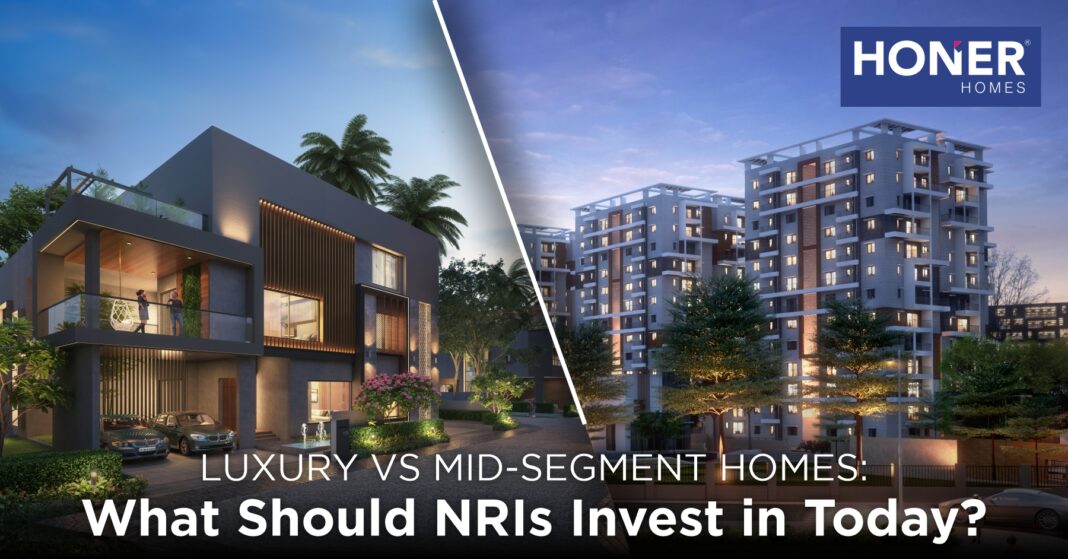For every Non-Resident Indian, the thought of owning a home in India carries more than financial value — it carries emotional weight. It’s about belonging, reconnecting with roots, and having a space to call your own when you return. For some, it’s a future retirement haven; for others, a smart investment to secure family wealth. But for many, it’s simply the joy of knowing that a part of them is anchored in the land they grew up in.
Yet, when NRIs decide to invest, they often face a crucial question: Should I buy a luxury home in an upscale enclave or a mid-segment home with stronger rental prospects? Both have their merits — one speaks to prestige and lifestyle, the other to liquidity and steady returns.
The Indian real estate market today is at an interesting juncture. According to reports, demand for luxury homes has soared. The sales of luxury housing grew by nearly 85% year-on-year in the first half of 2025 — showing how global Indians and HNIs are prioritising premium living. At the same time, mid-segment housing continues to dominate volumes across cities, making it the backbone of India’s housing story.
For NRIs looking to invest in Indian residential real estate, the choice between luxury and mid-segment properties is rarely just about price. It’s about goals — capital appreciation, rental income, emotional connection, legacy, tax efficiency, and ease of management from abroad. Here’s a clear, evidence-based guide to help NRIs decide which segment fits their priorities today.
Current market snapshot (why timing matters)
India’s premium and luxury housing demand has surged in recent months: luxury housing sales grew dramatically, driven in part by strong demand from HNIs and NRIs. Premium properties (INR 1 crore+ / $130k+) are taking a larger share in several markets, while mid-segment stock still dominates volumes overall.
What NRIs typically want from a property
· Capital appreciation over medium–long term tailored to investment.
· Reliable rental income when not occupying the home
· Low management hassle while abroad (property management, maintenance)
· Legal clarity & ease of repatriation of sale proceeds or rental income
· Emotional connection associated with a home to return at the motherland
Match your priority to the segment that best delivers it.
Why can NRIs consider Luxury properties?
1. Strong capital appreciation potential
Luxury stock in prime micro-markets has seen robust demand and sharper price appreciation lately. Developers are focused on premium launches and HNI buyers, which fuels appreciation and limited supply dynamics. For NRIs seeking long-term capital growth, luxury can outperform in elite pockets.
2. Tenant profile & rental absolute yields
While percentage rental yields on luxury homes tend to be lower (often ~2.5–4%), the absolute rental amount is significantly higher — attractive if you prefer premium tenants (corporate executives, expats) and want quality maintenance of your asset.
3. Amenities, prestige, and resale attractiveness to similar buyer cohorts
Luxury projects offer concierge services, tight security, branded fittings and finishes — features that make re-marketing to NRIs, corporate transferees, and wealthy domestic buyers easier.
4. Portfolio diversification & trophy asset
For HNIs and those building a high-net-worth real estate portfolio, a few luxury assets in top cities can serve as a “trophy” or a benchmark asset holdings and hedge against inflation and currency fluctuations.
Why consider Mid-Segment properties?
1. Higher percentage rental yields and steady cash flow
Mid-segment homes (the mass/mid-market) typically show higher gross yields — often 4–6% — which improves cashflow, especially in high-demand rental corridors. For NRIs who want income while holding the asset, mid-segment often wins.
2. Greater market liquidity and larger buyer pool
Mid-segment units make up the bulk of transactions in many cities; resale is generally easier because of a larger pool of buyers (young professionals, families). For NRIs who may sell within 5–7 years, liquidity matters.
3. Lower ticket size — attractive ROI and faster breakeven
Lower acquisition cost and competitive yield profile mean shorter payback periods for rental-driven investors. Mid-segment is often the sweet spot for steady returns with moderate risk.
4. Built for demand — infrastructure & affordability
Many developers still prioritise mid-segment launches; in recent updates, mid-segment remains the backbone of city volumes — highlighting ongoing demand and developer focus.
NRI-specific considerations (legal, financial & practical)
1. Repatriation & RBI rules: NRIs can repatriate proceeds (sale/ rental) subject to RBI norms and documentation — consult a tax/legal advisor early.
2. Taxation & compliance: Rental income is taxable in India; TDS may apply on rent and sale proceeds. Capital gains tax rules differ by holding period (short vs long). Use Double Taxation Avoidance Agreement (DTAA) benefits where applicable.
3. Home loans for NRIs: NRIs can access attractive home loans from Indian banks. If aiming to purchase the property, the person must compare offers and check documentation requirements (NRE/NRO accounts, power of attorney options).
4. Due diligence & title clarity: Always buy RERA-registered projects from reputed builders; verify title clearances and project delivery track record.
While Luxury properties offer prestige, potential outsized capital appreciation in marquee micro-markets, and access to premium renters — best for NRIs with long investment horizons and high net worth, Mid-segment offers better percentage yields, higher liquidity, and a broader buyer/renter base — ideal for NRIs prioritising cash flow and easier exit options.
Whichever path you choose, you must consider location, developer credibility, paperwork, and a trusted local team to manage the asset.
- What’s the main difference between luxury and mid-segment homes for NRIs?
Luxury homes focus on premium locations, superior amenities, and exclusivity, whereas mid-segment homes offer better rental yields, affordability, and easier resale due to a larger buyer base. While Honer Signatis & Honer Richmont, two ultra-luxury projects of Honer Homes, are considered among the luxury projects. However, their first project, Honer Vivantis, is part of mid-segment residential projects.
- Which option provides better rental income — luxury or mid-segment homes?
Mid-segment homes typically offer higher percentage rental yields (4–6%) compared to luxury homes (2.5–4%), making them better for steady cash flow.
- Are luxury homes better for long-term capital appreciation?
Yes. Luxury homes in prime micro-markets often experience sharper price appreciation due to limited supply, high-end demand, and brand value — ideal for long-term wealth creation.
- What legal factors should NRIs consider before investing
NRIs must ensure the property is RERA-registered, verify title clarity, understand repatriation rules, and comply with taxation norms under RBI regulations.
- Which investment is easier to manage from abroad?
Mid-segment homes are generally easier to manage and resell, while luxury properties may need dedicated property management due to higher maintenance and exclusivity factors.


















































